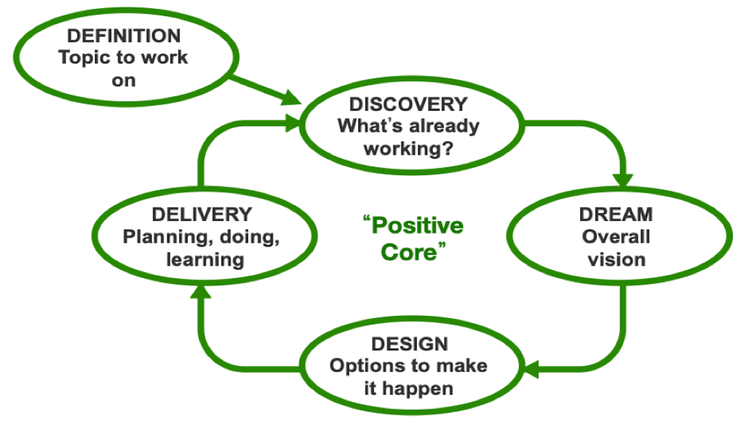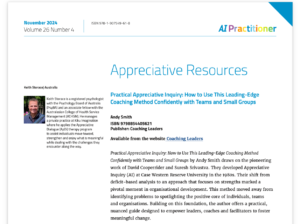Using the 5-D Format in One-to-One Coaching

[ad_1]

The 5-D format is the most widely used way of structuring Appreciative Inquiry processes, and by far the one that I have the most personal experience with. Although it originated, like Appreciative Inquiry as a whole, in the field of organisational development, it translates very nicely to one-to-one coaching, as well as team coaching.
In the ‘Two Simple Appreciative Practices’ chapter of their excellent book Conversations Worth Having, Second Edition: Using Appreciative Inquiry to Fuel Productive and Meaningful Engagement, Jackie Stavros and Cherie Torres identify two activities that I think of as a (very) high-level description of the essence of Appreciative Inquiry. These are positive framing (‘flipping’ problems so that you’re focusing on what you want, rather than what you want to get away from), and generative questions (questions that stimulate new ideas, new ways of looking at things, and motivating images of desired futures). We can look at the 5-D format as one way of structuring a coaching conversation so that these practices can happen.
Here’s how we could use the 5-D model in a one-to-one coaching session. In the Definition stage, we find out what the client wants to get from the conversation. In a formal coaching relationship, especially in a corporate setting, this would be related to the overall aim of the coaching process. In a less formal coaching conversation, it might be about finding out the coachee’s best hopes for what they want to get from it.
In either case, if the conversation starts with the client describing a problem to be solved, our main task in the Definition stage is to assist the client in flipping the problem so that it’s reframed as an affirmative topic.
In the Discovery stage, we explore what’s already working (or has worked in the past) for the client in relation to the affirmative topic. This provides a solid foundation for the client to build a vision of their ideal future in the Dream stage that follows.
The Design stage in one-to-one coaching is about the client generating ideas and options for how to bring the Dream into reality. Finally, in the Delivery stage (also known as ‘Destiny’, or in some recent descriptions of Appreciative Inquiry, ‘Deploy’), the client chooses which of the ideas from the Design stage they want to put into action. This stage could also include evaluating the choices to make sure they are robust, what evidence would tell the client they are on the right track, how they will learn from the results they get, and possibly a formal action plan.
In subsequent sessions, the same stages (minus the Definition stage, so it becomes the ‘4-D’ format), can be used as a review, to Discover what worked well, make any additions or amendments to the Dream in the light of experience, Design new ideas to build on success or fix any flaws that have become apparent, and adjust the actions or plan for Delivery accordingly.
The 5-D (and indeed 4-D) formats are not a rigid, procedural one-way street. They’re more like a road map to remind you where you are in the coaching process at any given moment. It’s possible to return to an earlier stage if needed; so, for example, what the client finds in the Discovery stage might prompt a return to the Definition stage to change the scope or focus of their affirmative topic. Or, once the Dream has been created, it may be useful to go back to the Discovery stage to look for experiences of where success is already happening, even if only partially.
In future articles we’ll explore what happens in each stage in more depth.
[ad_2]




